#hermatypic coral
Explore tagged Tumblr posts
Text
Some Geology Vocabulary
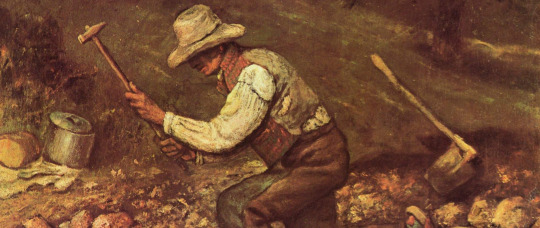
for your next poem/story (pt. 1)
Abyssal plain - A flat region of the deep ocean floor.
Aeolian - Describes materials formed, eroded, or deposited by or related to the action of wind.
Braided stream - A sediment-clogged stream that forms multiple channels that divide and rejoin.
Colluvium - A general term applied to loose and incoherent deposits, usually at the foot of a slope or cliff and brought there chiefly by gravity.
Conchoidal - Resembling the curve of a conch shell and used to describe a smoothly curved surface on a rock or mineral; characteristic of quartz and obsidian.
Devitrification - Conversion of glass to crystalline material.
Dune - A low mound or ridge of sediment, usually sand, deposited by the wind.
Ephemeral lake - A short-lived lake.
Estuary - The seaward end or tidal mouth of a river where freshwater and seawater mix.
Euhedral - A grain bounded by perfect crystal faces; well-formed.
Fenestral - Having openings or transparent areas in a rock.
Fluvial - Of or pertaining to a river or rivers.
Friable - Describes a rock or mineral that is easily crumbled.
Granoblastic - Describes the texture of a metamorphic rock in which recrystallization formed crystals of nearly the same size in all directions.
Hermatypic - Describes a type of reef-building coral that is incapable of adjusting to conditions lacking sunlight.
Hot spring - A thermal spring whose temperature is above that of the human body.
Isthmus - A narrow strip or neck of land, bordered on both sides by water, connecting two larger land areas.
Lacustrine - Describes a process, feature, or organism pertaining to, produced by, or inhabiting a lake.
Lithify - To change to stone, or to petrify; especially to consolidate from a loose sediment to solid rock.
Lunar tide - The part of the tide caused solely by the tide-producing force of the Moon.
Source ⚜ More: Word Lists
#geology#terminology#word list#spilled ink#writing reference#langblr#linguistics#writeblr#literature#writers on tumblr#writing prompt#poetry#dark academia#poets on tumblr#light academia#studyblr#creative writing#writing inspiration#writing inspo#writing ideas#gustave courbet#writing resources
121 notes
·
View notes
Text
Round 2.5 - Cnidaria - Hexacorallia
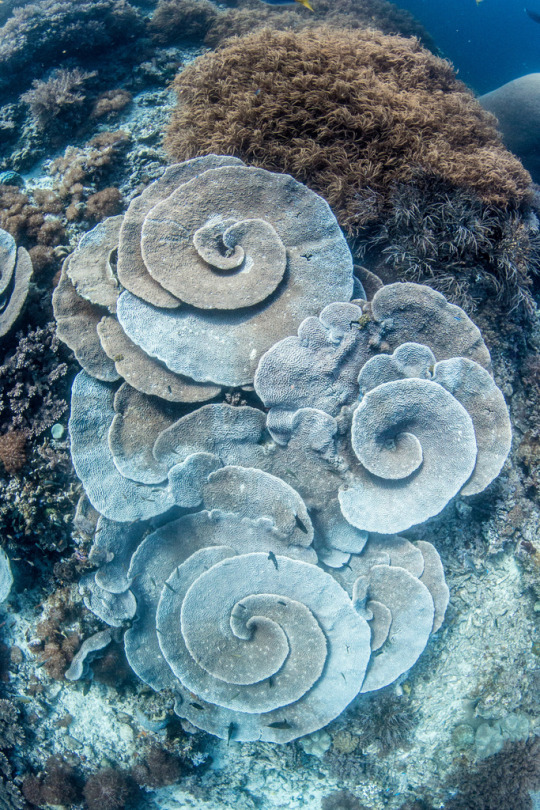
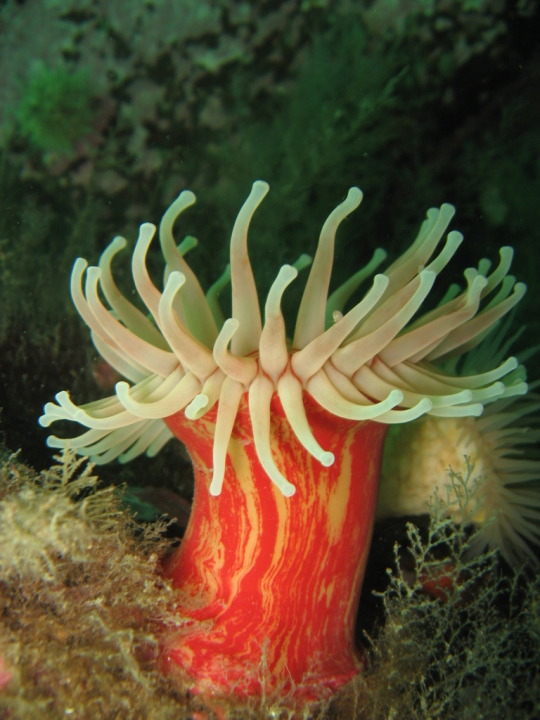
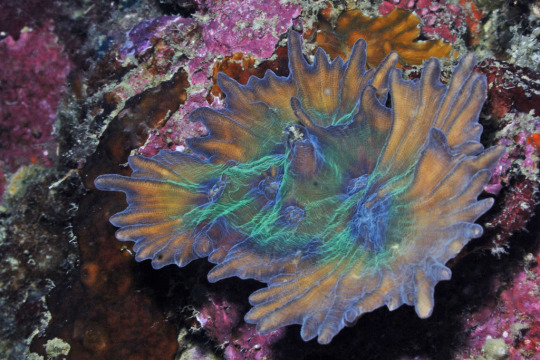

(Sources - 1, 2, 3, 4)
The anthozoan class Hexacorallia contains five extant (living) orders: Actiniaria (“sea anemones”), Antipatharia (“black corals” or “thorn corals”), Corallimorpharia (“false corals”), Scleractinia (“stony corals” or “hard corals”), and Zoantharia (“zoanthids”). This class contains many of the most important reef builders: the stony corals, sea anemones, and zoanthids.
Like all anthozoans, these organisms are formed of individual soft polyps which in some species live in colonies and can secrete a calcite skeleton. Some species live as solitary polyps. Hexacorals are distinguished from Octocorals by having six or fewer axes of symmetry in their body structure, and tentacles which are simple and unbranched and normally number more than eight. Reef-building or hermatypic corals are mostly colonial, building a communal skeleton around their colony. Corallimorphs are similar to the stony corals, except for the stony skeleton, and have a tendency to overgrow reefs in a carpet formation. Most sea anemones are solitary, single polyps attached to a hard surface by their base but some species float near the surface, or can deatach to escape predators.
Hexacorals are filter-feeding carnivores, using their tentacles armed with stinging cells, called cnidocytes, to catch and neutralize plankton and draw it into their mouth. Larger polyps are able to take correspondingly larger prey, including various invertebrates and even fish. Many species have separate sexes, the whole colony being either male or female, but others are hermaphroditic, with individual polyps having both male and female gonads. Most species release gametes into the sea where fertilisation takes place, and the planula larvae drift as plankton, but a few species brood their eggs. Once the larvae settle in an area, they will metamorphize into a polyp. In colonial species, this initial polyp will repeatedly divide to give rise to an entire colony. Hexacorals can also reproduce by fragmentation, where part of a colony becomes detached and reattaches elsewhere, cloning polyps to grow the colony in the new area.
Hexacorals have existed since the Fortunian. Mackenzia, from the Middle Cambrian Burgess Shale of Canada, is the oldest fossil identified as a sea anemone. Nonetheless, many hexacorals have been declining in numbers and are expected to continue declining due to poaching, ocean acidification and climate change.

Propaganda under the cut:
Hexacorals provide housing, shelter, food, and protection for so many other animals. They are The Givers of the Animal Kingdom.
The largest coral ever recorded, a Pavona clavus colony dubbed the “mega coral” lives off the Solomon Islands. It is 34m (112 ft )wide, 32m (105 ft) long and 4.9m (16 ft) high, larger than a Blue Whale, composed of nearly one billion polyps, and more than 300 years old!
Coral is loud. It can hear and it communicates with each other via sound. We’re only beginning to discover this information and understand the implications of it, and more research needs to be done, but the amount of noise-making humans do in the ocean tends to disrupt the communication corals have with each other and other reef life.
Black Corals have historically been used by Pacific Islanders for medical treatment and in rituals, and are used in modern day for making jewelry.
Sea anemones and zoanthids are popular in the aquarium trade, however, their popularity threatens some populations as the trade depends on collection from the wild.
In southwestern Spain and Sardinia, the Snakelocks Anemone (Anemonia viridis) is consumed as a delicacy. The whole animal is marinated in vinegar, then coated in a batter similar to that used to make calamari, and deep-fried in olive oil.
Most sea anemones are harmless to humans, but a few highly toxic species (notably Actinodendron arboreum, Phyllodiscus semoni and Stichodactyla spp.) have caused severe injuries and are potentially lethal.
Clownfish and Anemonefish (Subfamily Amphiprioninae) are most famous for having a mutualistic relationship with sea anemones, receiving protection from predators by hiding in the anemone's stinging tentacles, and providing the anemone nutrients in the form of faeces. Some other animals have been recorded utilizing sea anemones in a similar way, including cardinalfish, juvenile threespot dascyllus, incognito (or anemone) gobies, juvenile painted greenlings, various crabs (such as Inachus phalangium, Mithraculus cinctimanus and Neopetrolisthes), shrimp (such as certain Alpheus, Lebbeus, Periclimenes and Thor), opossum shrimp (such as Heteromysis and Leptomysis), and various marine snails. One of the more unusual relationships are those between certain anemones (such as Adamsia, Calliactis and Neoaiptasia) and hermit crabs or snails, where the anemones live on the shell of the hermit crab or snail, providing protection from predators while being provided with transportation. Another unusual relationship is between Bundeopsis or Triactis anemones and Lybia boxing crabs, where the small anemones are actually carried around in the claws of the boxing crab as little weapons.
Look at this anemone eating an entire Mola:
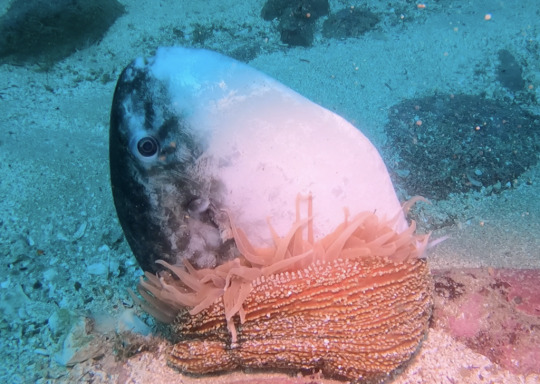
(source)
75 notes
·
View notes
Text
Why is coral different in shapes and sizes?
There are over two thousand different types of coral that form colonies that play a key role in marine environments. Here is some information I found on different coral species.
Hard Coral:
Hard coral includes species such as brain coral and elkhorn coral. Hard corals are considered to be hermatypes, which require a certain type of algae that live within their tissues, which is necessary for their survival. These organisms are what give corals their colors, which is dependent upon where they are living. The shape and appearance of each coral are dependent upon its species type, location, depth, water movement, and many other factors.
hard corals build coral reefs. A coral reef begins when the coral polyp attaches itself to a rock on the seafloor. This one coral polyp then begins to divide or bud into thousands and thousands of clones of itself. Polyps and their calcareous skeletons connect to one another which creates a colony that will act as one. As this colony grows over hundreds and thousands of years it will join with other colonies and become a reef.

Soft Coral:
Soft corals often resemble plants and trees. They are soft and bendable so they do not have stony skeletons like hard coral. For protection and support, they grow woodlike cores for stability. Examples of soft coral in the Bahamas and Caribbean include sea fingers or sea whips. Though many utilize their presence, soft corals will typically eat any type of passerby out of the water column. These types of corals do not produce calcium carbonate, rather they contain spiny skeletal sclerites. These give the softer corals some protection and support. Soft species also prefer to live in nutrient-rich waters with less intense light.


Deep Sea Coral:
Deep-sea coral can be found in the dark depths of up to 6,000 m (20,000 ft) below the surface of the ocean. These corals live in icy cold water with little to no sunlight. These corals, like shallow species, can exist as single polyps or multiple, living in complex colonies made up of different species. Since these species do not require sunlight or warm water, they can grow in a vast array of waters around the world. They have even been found in waters as cold as -1 degrees Celsius. Since these corals live without sunlight they contain no zooxanthellae. This means these corals must obtain their energy and nutrients elsewhere. They do this by trapping tiny organisms in passing currents.

2 notes
·
View notes
Text
Coral Reef
What Are Coral Reefs?Coral reef ecosystemsWhat if there were no coral reefs?Are corals animals or plants?References: What Are Coral Reefs? Coral reefs are large underwater structures composed of the skeletons of colonial marine invertebrates called coral. The coral species that build reefs are known as hermatypic, or “hard,” corals because they extract calcium carbonate from seawater to create…

View On WordPress
0 notes
Text
Hermatypic Corals

#studyblr#notes#marine science#marine biology#science#biology#bio#scienceblr#sciblr#corals#hermatypic corals#coral
14 notes
·
View notes
Photo

peekaboo
#hermaeus mora#hematite marble#hambone dora#superfluous flora#chartreuse fedora#himalayas aurora#harrison ford#horoscope torah#hemmorhage moron#belated mormon#humongous aura#rowboat girlyman#hermetic mold#herringbone moral#hornswaggle morays#hypercube morsels#homebrown morocco#homebrew formula#hermatypic coral#hygenic morpheus#skyrim
2 notes
·
View notes
Text
Not so soft coral, Vol 1 You’ve heard of red coral, and white coral, now get ready for...

Blue ridge coral, Heliopora coerulea! there are several weird things about this species, for starters, it is not a member of scleratinia, its an octocoral, or as octocorals are often called in the aquarium trade a soft coral. Doesn’t look very soft to me... It forms massive plates, branches, or columns, also, its the only member of the genus heliopora, the family Helioporidae, and one of the only two extant members of order helioporacea, the only known coral to produce a blue skeleton, and one of the only hermatypic (reef building) octocorals. Why is it blue? Heliopora coerulea includes iron salts in its aragonite skeleton. It also makes an excellent aquarium specimen, even though it is not terribly colorful on the outside, it is a very hardy, and photosynthetic coral (if you do keep live corals please try to purchase aquacultured specimens) Intererstingly, its not the only member of octocorals to produce a skeleton.
Next
#Blue#unique#monotypic#cnidaria#corals#coral reefs#one of a kind#marine biology#marine life#sea life#tropics#weird#ocean#oceans#tropical#reefs#special#not-so-soft-coral#fun fact#gemstones#series#not so soft coral
70 notes
·
View notes
Text
What is an Atoll? Know About this Natural Creation
Atolls develop with underwater volcanoes and seamounts. Firstly, the volcano erupts, piling up lava on the seafloor. As the volcano continues to erupt, the elevation of the seamount grows higher, thus breaking the surface of the water. The top of the volcano becomes an oceanic island. The next stage of this formation involves tiny sea animals or coral that begin to build a reef around the island. Such corals building reefs are called hermatypic corals which further create a hard exoskeleton of limestone. Eventually, billions of these limestones form a reef. คาสิโนออนไลน์
0 notes
Text
Ecosystem Description

Coral reefs are unique ecosystems located underwater, specifically in salt water. They’re known for their many species of fish and reef-building corals that a re known as hermatypic because they have hard calcium carbonate skeletons. There are many species of corals, but they are all categorized by shape: Massive, Encrusting, Branching, and Foliose.
Source
Shimokawa, Shinya, et al. “Thermodynamics of Coral Diversity - Diversity Index of CoralDistributions in Amitori Bay, Iriomote Island, Japan and Intermediate Disturbance Hypothesis.” IntechOpen, IntechOpen, 21 Dec. 2015, https://www.intechopen.com/books/recent-advances-in-thermo-and-fluid-dynamics/thermodynamics-of-coral-diversity-diversity-index-of-coraldistributions-in-amitori-bay-iriomote-isla.
0 notes
Text
ما هي الشعاب المرجانية ؟
ما هي الشعاب المرجانية ؟
ما هي الشعاب المرجانية ؟
وفقًا لرابطة الشعاب المرجانية CORAL، وهي منظمة بيئية غير ربحية . الشعاب المرجانية Coral reefs هياكل كبيرة تحت البحر ، تتشكل من الهياكل العظمية للمستعمرات اللافقارية Invertebrates المائية، لذلك تُسمى المرجانية . تُعرف أنواع المرجان التي تشارك في بناء الشعب المرجانية بمصطلح يوناني hermatypic (أي غير متأثرة بالعوامل الخارجية) أو بمعنى آخر صلبة؛ ذلك لأنها تستخرج كربونات…
View On WordPress
0 notes
Video
youtube
Learn how to pronounce Hermatypic in English --- HERMATYPIC Pronunciation of Hermatypic: /ˌhər-mə-ˈti-pik/ adjective Definition of Hermatypic: building reefs (hermatypic corals) ★ http://Learn2Pronounce.com ★ How to pronounce Hermatypic | English pronunciation: https://youtu.be/QJ7f2kq2evM
#how to pronounce How to pronounce Hermatypic | English pronunciation#pronunciation of How to pronoun
0 notes
Text
After snorkeling off the coast of the Island of Roatan, I learned a little bit about a kind of coral called Fire Coral. I was told not to touch it for it can deliver a painful sting that would send me back to the mainland for treatment. While snorkeling, I did not touch the Fire Coral but was able to recognize it as I swam warily past it with the group. After this experience and the creation of this blog I thought Fire Coral would be a good place to start when I dove into coral research by species.
To start off, Fire Coral is like many other species of coral in that they are known as 'reef-building' or hermatypic coral. This means they live above the 50m depth line, which is also known as the photic zone. The photic zone is exposed to a high intensity of sunlight where photosynthesis can occur very easily. Fire Coral have smooth surfaces and tiny pores with thin hairs that cause the painful stings when touched or brushed. The thin hairs dotted along the Fire Coral are like colonies of tiny stinging jellyfish attached to a feather or seaweed-like structure. If anyone is to come into contact with these hairs, stinging nematocysts causes painful burn-like wounds wherever they touched. A toxin from the nematocysts is what generates the reaction which can be more severe in those with allergies. If this is the case, skin irritation can last for up to two weeks.
There are four kinds of Fire Coral that live in two separate places on planet Earth. The first two live in the Indo-Pacific and the second two live in the Western Atlantic. Colonies of this kind of coral can be found in shallow water with good circulation in the Red Sea, Samoa, South Africa, and most places in between. Often times they are overlooked due to their small size and tendency to attach to seaweeds and other submerged surfaces. They also get eaten by sea slugs, filefish, puffers, and moorish idols rather steadily.
The two kinds living in the Indo-Pacific are Branching Fire Coral and Blade Fire Coral. There is more known about the Branching Fire Coral than Blade Fire Coral. Branching Fire Coral, also known as Millepora Dichotoma or net fire coral is a species of hydrozoan with a calcareous skeleton. They usually grow into fan-shaped colonies up to 60cm across. In other cases, clumps can grow to be several meters across. Branching Fire Coral range from mustard to olive-yellow in color and grow transverse to the prevailing current so that they get the most exposure to passing food. The transverse growth patterns allow the coral to snare plankton from the passing current along exposed portions of upper reef slopes up to 15m below the surface. As for the second kind, Blade Fire Coral, not as much information is known. They too go by second and third names which are Millepora Platyphylla and plate fire coral. Blade Fire Coral reach maturity between three and eight years. The average generation time is ten years unless otherwise noted or discovered though they are expected to live longer.
As for the two kinds of Fire Coral living in the Western Atlantic, their common names are the same but their scientific names are slightly different. The first is Branching or Crenelated Fire Coral, sometimes called sea ginger or Millepora Alcicornis. This kind of Fire Coral also has a calcareous skeleton and grows in shallow waters. What makes it different from the Indo-Pacific Branching coral, besides location, is that they show a variety morphologies depending on location. Both the Indo-Pacific and Western Atlantic feed on plankton but while the first has zooxanthellae, the second has microalgae instead. As for the second kind of Western Atlantic Fire Coral, Blade Fire Coral, whose scientific name is Millepora complanata, it hardly differs from the rest. The colors it can be found in range from pale brown to cream with white tips dotting the blades and grow in thin upright plates with heights up to 20 inches.
While I learned fair amount about Fire Coral, I realized there isn't a large amount of information on them in general. The varieties between species was minimal besides some physical differences which is expected. All in all I feel that I could have a decent conversation about Fire Coral but not about any other kind which is why I will be continuing my species research over the course of the next two or three weeks depending on how many different ones there are out in the deep blue sea.
[ sources ]
0 notes
Text
Coral Physiology
-- cnidarians
-- capture food with stinging cells called cnidocytes
-- related closely with sea anemones and jellyfish
-- live entire adult lives as polyps
-- polyps are sessile
-- polyps tend to be simple in appearance
-- two categories -- ahermatypic -- soft corals -- do not build reefs -- hermatypic -- hard corals -- build reefs
#studyblr#notes#marine science#marine biology#coral physiology#physiology#corals#coral#cnidarians#cnidocytes#hermatypic#ahermatypic#polyps
11 notes
·
View notes
Text
Hermatypic Corals
-- hard corals
-- reef-building corals
-- coral polyps always live in colonies
-- always include zooxanthellae
-- colonies begin when a planktonic coral larvae settles on something hard
-- larvae goes through metamorphosis to become a coral polyp
-- if the original polyp survives and does well, it reproduces asexually -- budding
-- usually all polyps in a coral colony are genetically identical to the founder polyp
-- secretes calcium carbonate to stick to substrate
#studyblr#notes#marine science#marine biology#coral#coral reefs#reefs#hermatypic corals#zooxanthellae#ocean#seas#oceanography
9 notes
·
View notes
Text
Coral and Reef Vocabulary
Ahermatypic -- soft corals -- do not build reefs
Hermatypic -- hard corals -- build reefs
Zooxanthellae -- photosynthetic dinoflagellates -- live in the tissue of many invertebrates -- symbiotic
Geomorphology -- study of the characteristics, origin, and development of landforms
Fringing Reef -- reef close to and surrounding newer volcanic islands or that borders continental landmasses
Barrier Reef -- a reef separated by a lagoon from the land mass its associated with
Atoll -- coral reef -- somewhat circular in shape -- central lagoon
Patch Reef -- small, isolated reef
Patreon | Ko-fi
#studyblr#notes#marine sci#marine sci notes#marine science#marine science notes#marine biology#marine biology notes#marine bio#marine bio notes#science#biology#science notes#scienceblr#oceanography#oceanography notes
9 notes
·
View notes
Text
Hermatypic Coral Polyp Cross-Section

#studyblr#notes#marine science#marine biology#corals#coral physiology#coral anatomy#coral biology#coral bio#bio
26 notes
·
View notes